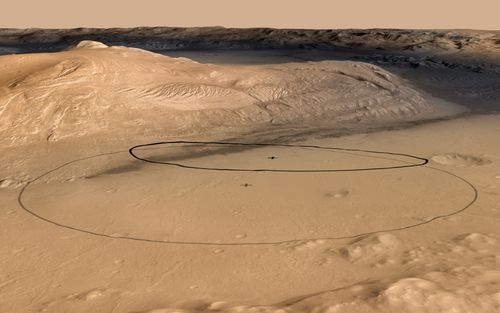In just a few more days, the largest and most complex spacecraft ever to land on Mars will either have six wheels on the ground or will be a smoking billion-dollar crater. I’ve posted this video before, but it’s cool enough for a repeat:
The exact time of touchdown on Mars will be 1:31 a.m. EDT on Monday morning, August 6th, plus or minus a minute or two. This is, as NASA notes, the “Earth-received” time which accounts for the one-way light travel time of seven minutes between the two planets. It will most likely be broadcast on the cable news networks (really—what else is there at 1:30 a.m.), but you can watch live streaming at these sites:
NASA TV: http://www.nasa.gov/multimedia/nasatv/index.html
JPL (Jet Propulsion Laboratory) Ustream HD: http://www.ustream.tv/NASAJPL2
What will you see? A bunch of engineers sitting in front of computer screens, looking tense, and then either giving each other high fives or looking very grim. The rover itself will undergo a careful checkout procedure before it begins sending back scientific data—and pictures.
Here is where it is headed: Gale crater, with a central mountain showing multiple layers of rock. Curiosity is powerful enough to travel to and to climb that mountain. The ellipse shows the target landing area; it is 20 by 7 kilometers (12 by 4 miles). This after a journey of more than 350 million miles! The first image shows the crater with the original landing ellipse, the second with both the old and the new, smaller ellipse resulting from mid-course fine tuning of the trajectory.


This spacecraft will actually steer itself during the re-entry phase to further refine its landing spot. Rather than just drop like a rock, it will fire rockets to adjust its path, and swing in large S-curves to shed speed, just the Space Shuttle did when it dropped back to Earth.
There is a superb multi-part series beginning here about the complex procedure that will be used to land Curiosity, but for those with shorter attention spans, here is the lowdown:
How is this rover different from earlier ones? It’s a lot bigger, and will be powered by nuclear energy, not solar cells. This means it will have power regardless of light levels, and can stay active during the Martian winter when earlier rovers had to “hibernate”. This greater size and weight means it can’t use the airbag landing method pioneered by the Pathfinder mission and repeated with the Spirit and Opportunity rovers. Here is a video showing that. Bounce, bounce, bounce…
This looks much like the Curiosity landing sequence up to a point, the point being when those airbags inflate! So why can’t we use this same method for Curiosity? Because this rover is just too big and heavy: 2000 pounds for Curiosity versus 400 pounds each for Spirit and Opportunity.
OK, so why not just land it with rockets like the Viking landers of the 70s and the more recent Phoenix lander?
Remember that this is a rover. You want wheels on the ground, not landing legs. You could have a landing platform that the rover would roll off, but that would add weight to an already heavy spacecraft. Every unnecessary ounce takes away from the scientific instruments that are the whole reason for the mission. So, this incredibly complex landing sequence has sound engineering thought behind it. That doesn’t mean those engineers won’t be sweating it out with the rest of us!
Steering itself through the atmosphere, knowing when to initiate each step of this sequence, and landing on the surface—all of this requires autonomous judgment on the part of the spacecraft. Asking a question of the Earth-based controllers would require 14 minutes for a round trip. Sorry buddy, but you are on your own!
My wife and I just returned from a trip where we made extensive use of our GPS device. While the idea of a device that uses multiple Earth satellites and compensates for the effects of General Relativity is mind-blowing enough, I actually find the software that enables the easy use of this technology to be more impressive. Finding a particular brand of motel in a particular city, getting the phone number so we could call a reservation ahead, and having the device lead us straight to it within a minute of its estimated arrival time—all of that takes someone writing a lot of clever code. So if we wind up with six wheels on the surface of Mars next Monday morning, don’t forget to acknowledge the software guys who helped make it possible.



Leave a Reply